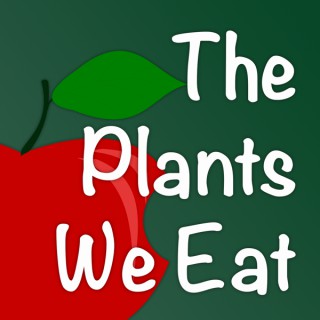The Plants We Eat
Follow The Plants We EatThe Plants We Eat is a podcast about the history, culture, and biology of the plants we eat.
UNC Charlotte Botanical Gardens
- Sep 15, 2020 LATEST EPISODE
- infrequent NEW EPISODES
- 18m AVG DURATION
- 50 EPISODES
Latest episodes from The Plants We Eat

I know, it doesn't sound tasty at all, but if you're a vegetarian looking for BBQ then this big guy is about as good as it gets!

It's great to be back! Let's start with a sticky little (okay, big) legume with a big flavor profile!

Cows provide us with leather and meat, but use a lot of grass, grain, and water. Silkworms provide us with silk and silkworm pupae, and all it costs are a few mulberry leaves!

The first in a short series that we're calling The Bugs We Eat. Sure it seems gross, but they're actually pretty good!

Yes, Marsh Mallows are a real thing -- and no, those fluffy white clouds you are placing into your hot cocoa are not real marshmallows.

Don't eat the berries! But the leaves....well, as long they're from the proper holly they're not bad at all!

The most amazing flower you will ever see, and a tasty fruit too!

For our 50th podcast -- Should we care whether a food is genetically modified? The short answer is yes. The long answer is quite a bit more complicated.

If it weren't for genetically modified papaya we might not have papaya at all.

A tasty little fruit that takes dozens if not hundreds of children's lives every year.

And for our last podcast of season 2, a (very) oldie but goodie!

What fruit is native to the United States, tastes oddly tropical, and is about as popular as eating mud? Yep, you got it -- the Paw Paw.

What does this attractive fruit have to do with nasty parasites? Listen and find out!

Let's not kid ourselves, this stuff is a weed.....but what a tasty weed it is!

Sassafras is best known as the source of the flavor for rootbeer, except that it isn't anymore -- because it's potentially quite dangerous.

If you were stranded on a desert island with only one plant, this is the one you should be stuck with!

With many flowers that fuse to become a single fruit, this South American native is a truly unique plant.

If you like your beer hoppy then you've got to know this little gem of a flower!

Not daring robberies or clever thefts, capers are little pickled....no wait, that would be telling! Listen to the podcast and find out. And if you have exciting plant ideas for our next season of The Plants We Eat then e-mail me at jgillman@uncc.edu

This is the most expensive spice in the world. Who would have thought it would have such a huge following in central Pennsylvania?

The title says vanilla, but you can't discuss vanilla without discussing the 12 year old orphaned slave who made vanilla production possible.

Despite the term "Georgia Peach" the peach isn't really a southern crop naturally, it became one out of necessity.

It's almost Thanksgiving! Time to pay homage to a sour native with a cult following.

Paprika: Sometimes it's dried, powdered peppers, and sometimes there's a little something extra.

Why the heck are banana seedless? And what is the difference between a banana and a plantain?

High in vitamin C, tasty, and readily available in backyards across America, this just might be the perfect scavenger food!

Pecans are an American original, but not all of them are eaten here. Just ask the Chinese.

From a beautiful shrub with stunning red berries to the roaster and finally your mug, coffee is as interesting as it is delicious.

To the uninitiated tomatoes seem like an amazing addition to any menu, but it isn't that simple. Over the centuries tomatoes have been a part of both delicious, and deadly, meals.

The story of the modern strawberry is really the story of a French spy and a brilliant teenager.

Garlic is one of those rare plants that just doesn't like to make seeds very much.








